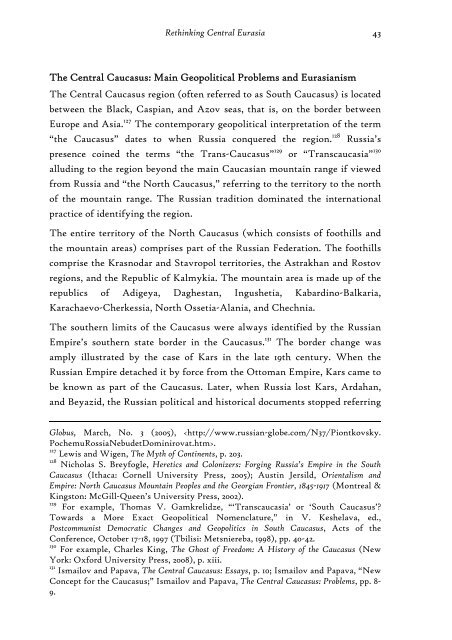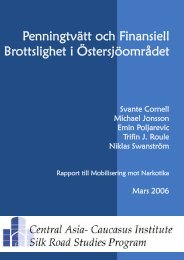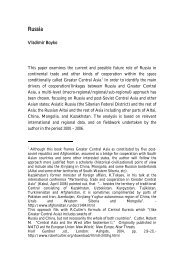Eurasianism and the Concept of Central Caucaso-Asia
Eurasianism and the Concept of Central Caucaso-Asia
Eurasianism and the Concept of Central Caucaso-Asia
Create successful ePaper yourself
Turn your PDF publications into a flip-book with our unique Google optimized e-Paper software.
Rethinking <strong>Central</strong> Eurasia 43<br />
The <strong>Central</strong> Caucasus: Main Geopolitical Problems <strong>and</strong> <strong>Eurasianism</strong><br />
The <strong>Central</strong> Caucasus region (<strong>of</strong>ten referred to as South Caucasus) is located<br />
between <strong>the</strong> Black, Caspian, <strong>and</strong> Azov seas, that is, on <strong>the</strong> border between<br />
Europe <strong>and</strong> <strong>Asia</strong>. 127 The contemporary geopolitical interpretation <strong>of</strong> <strong>the</strong> term<br />
“<strong>the</strong> Caucasus” dates to when Russia conquered <strong>the</strong> region. 128 Russia’s<br />
presence coined <strong>the</strong> terms “<strong>the</strong> Trans-Caucasus” 129 or “Transcaucasia” 130<br />
alluding to <strong>the</strong> region beyond <strong>the</strong> main Caucasian mountain range if viewed<br />
from Russia <strong>and</strong> “<strong>the</strong> North Caucasus,” referring to <strong>the</strong> territory to <strong>the</strong> north<br />
<strong>of</strong> <strong>the</strong> mountain range. The Russian tradition dominated <strong>the</strong> international<br />
practice <strong>of</strong> identifying <strong>the</strong> region.<br />
The entire territory <strong>of</strong> <strong>the</strong> North Caucasus (which consists <strong>of</strong> foothills <strong>and</strong><br />
<strong>the</strong> mountain areas) comprises part <strong>of</strong> <strong>the</strong> Russian Federation. The foothills<br />
comprise <strong>the</strong> Krasnodar <strong>and</strong> Stavropol territories, <strong>the</strong> Astrakhan <strong>and</strong> Rostov<br />
regions, <strong>and</strong> <strong>the</strong> Republic <strong>of</strong> Kalmykia. The mountain area is made up <strong>of</strong> <strong>the</strong><br />
republics <strong>of</strong> Adigeya, Daghestan, Ingushetia, Kabardino-Balkaria,<br />
Karachaevo-Cherkessia, North Ossetia-Alania, <strong>and</strong> Chechnia.<br />
The sou<strong>the</strong>rn limits <strong>of</strong> <strong>the</strong> Caucasus were always identified by <strong>the</strong> Russian<br />
Empire’s sou<strong>the</strong>rn state border in <strong>the</strong> Caucasus. 131 The border change was<br />
amply illustrated by <strong>the</strong> case <strong>of</strong> Kars in <strong>the</strong> late 19th century. When <strong>the</strong><br />
Russian Empire detached it by force from <strong>the</strong> Ottoman Empire, Kars came to<br />
be known as part <strong>of</strong> <strong>the</strong> Caucasus. Later, when Russia lost Kars, Ardahan,<br />
<strong>and</strong> Beyazid, <strong>the</strong> Russian political <strong>and</strong> historical documents stopped referring<br />
Globus, March, No. 3 (2005), .<br />
127 Lewis <strong>and</strong> Wigen, The Myth <strong>of</strong> Continents, p. 203.<br />
128 Nicholas S. Breyfogle, Heretics <strong>and</strong> Colonizers: Forging Russia’s Empire in <strong>the</strong> South<br />
Caucasus (Ithaca: Cornell University Press, 2005); Austin Jersild, Orientalism <strong>and</strong><br />
Empire: North Caucasus Mountain Peoples <strong>and</strong> <strong>the</strong> Georgian Frontier, 1845-1917 (Montreal &<br />
Kingston: McGill-Queen’s University Press, 2002).<br />
129 For example, Thomas V. Gamkrelidze, “‘Transcaucasia’ or ‘South Caucasus’?<br />
Towards a More Exact Geopolitical Nomenclature,” in V. Keshelava, ed.,<br />
Postcommunist Democratic Changes <strong>and</strong> Geopolitics in South Caucasus, Acts <strong>of</strong> <strong>the</strong><br />
Conference, October 17-18, 1997 (Tbilisi: Metsniereba, 1998), pp. 40-42.<br />
130 For example, Charles King, The Ghost <strong>of</strong> Freedom: A History <strong>of</strong> <strong>the</strong> Caucasus (New<br />
York: Oxford University Press, 2008), p. xiii.<br />
131 Ismailov <strong>and</strong> Papava, The <strong>Central</strong> Caucasus: Essays, p. 10; Ismailov <strong>and</strong> Papava, “New<br />
<strong>Concept</strong> for <strong>the</strong> Caucasus;” Ismailov <strong>and</strong> Papava, The <strong>Central</strong> Caucasus: Problems, pp. 8-<br />
9.






